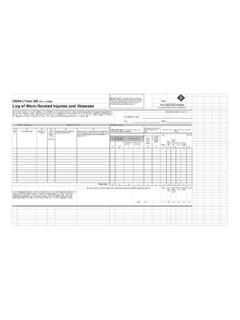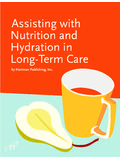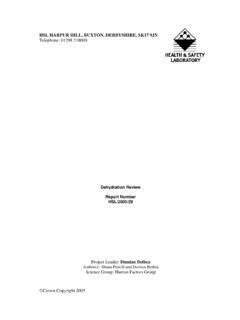Transcription of Topic 470: Worker Hydration - Grosslight Insurance
1 Tailgate/Toolbox Safety TrainingSafety Services Company-Safety Meeting Division, PO Box 6408 Yuma, AZ 85366-6408 Toll Free (866) 204-4786 470 Safety Services Company Company Name: _____ Job Site Location: _____ Date: _____Start Time: _____ Finish Time: _____ Foreman/Supervisor: _____ Topic 470: Worker Hydration Introduction: Dehydration occurs when the body s output of water is greater than the body s intake. Excessive heat, sweating, and decreased water intake can lead to dehydration. Following are guidelines for the prevention of dehydration.
2 Mild Dehydration: Drinking plain water may be all that is needed. However, when both water and electrolyte losses have occurred, salt (especially sodium and potassium), must also be replaced. Flavored commercial drinks, with electrolytes, have been formulated to replace the salts lost during vigorous work. To maintain water balance within the body, workers who are not excessively sweating, should drink at least 1 quart of water. To protect against dehydration, drink 1 to 2 quarts of water while working on the job site. Profuse sweating can dramatically increase the amount of water lost during the day.
3 Always have plenty of cool, potable water available at each job site. Make sure a Drinking Water label is stamped on the cooler complying with OSHA regulations. Use plastic water coolers that have pressure fit lids to prevent mold and mildew. Use galvanized steel water coolers when working in harsh and inclement conditions. Attach cup dispensers to the side of the coolers to allow workers safe drinking vessels. Make sure water is available when working on elevated platforms or roofs. When operating heavy machinery, keep a thermos of water readily available.
4 First Aid Change the water supply frequently when it is kept in portable coolers. Lay the Worker down Take cool-down breaks when working in extreme heat. Loosen the workers clothing Encourage fellow workers to drink water while working together. Give plenty of water to drink Always do the heaviest work during the coolest part of the day. Contact paramedics. Damage to the kidneys, liver, and brain can occur from dehydration. Consult a doctor about safely replacing fluids if you have heart or kidney problems. Know the signs and symptoms of dehydration. Heat Exhaustion HeatstrokeSymptoms: Weakness Signs: High Pulse Rates Symptoms: Chills Signs: Red Face Fatigue Extreme Sweating Restlessness Disorientation Blurry Vision Pale Face Irritability Erratic Behavior Dizziness Insecure Walking Shivering Collapse Over- Hydration : Over- Hydration occurs when the body s intake of water is greater than its output.
5 Excess water in the body causes the sodium in the bloodstream to become overdiluted. Limit intake of water when suffering from heart, kidney, or liver problems. Do not drink more than two gallons of water in a single work day. Symptoms from over- Hydration can be mental confusion, seizures, and coma. Contact a doctor to prescribe a diuretic to increase excretion of excess water. Heat Stress: In heat stress environments, the body cools itself by perspiring. When this occurs, much more is lost than water. Magnesium, potassium, sodium, and calcium are depleted. These electrolytes are crucial to maintaining healthy muscles and a productive energy level.
6 Specific (electrolyte) drinks need to be available for workers when heat stress indicators are present. Beware of heat exhaustion, heat cramps, or heat stroke when involved in strenuous work when it is 90OF or above. Take time to allow the body to adjust to high-heat and high-humidity environments, before beginning operations on the job. Do not depend on thirst, or sweat as an indicator of escalating body heat. Drink fluids with electrolytes at regular intervals. Conclusion: Hydration is essential and must be consciously maintained during the hot season. Use these guidelines to stay healthy.
7 Work Site Review Work-Site Hazards and Safety Suggestions: _____ Personnel Safety Violations: _____ Employee Signatures: (My signature attests and verifies my understanding of and agreement to comply with, all company safety policies and regulations, and that I have not suffered, experienced, or sustained any recent job-related injury or illness.) _____ _____ _____ _____ _____ _____ _____ _____ _____ _____ _____ _____ _____ _____ _____ _____ _____ _____ Foreman/Supervisor s Signature: _____ These guidelines do not supercede local, state, or federal regulations and must not be construed as a substitute for, or legal interpretation of, any OSHA regulations.
8








